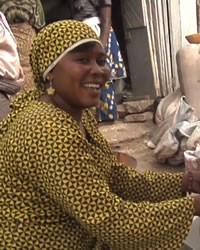Gur, Ninkare in Burkina Faso

Photo Source:
Copyrighted © 2025
Wycliffe Global Alliance All rights reserved. Used with permission |
Send Joshua Project a map of this people group.
|
| People Name: | Gur, Ninkare |
| Country: | Burkina Faso |
| 10/40 Window: | Yes |
| Population: | 65,000 |
| World Population: | 665,000 |
| Primary Language: | Farefare |
| Primary Religion: | Ethnic Religions |
| Christian Adherents: | 6.00 % |
| Evangelicals: | 2.50 % |
| Scripture: | Complete Bible |
| Ministry Resources: | Yes |
| Jesus Film: | Yes |
| Audio Recordings: | Yes |
| People Cluster: | Gur |
| Affinity Bloc: | Sub-Saharan Peoples |
| Progress Level: |
|
Introduction / History
The Gur are located in south central Burkina Faso and across the border in Ghana, just west of the Red Volta River. The terrain is grassland and bush with sparse vegetation. It is a flat country with only an occasional range of hills, and patches of sand are found throughout the area. In the shade, the average temperature is 85°F. During the dry season, the climate is hot and dry, and the crops do not grow well.
The origin of the Gur is not clear; however, some believe that they came from near Navrongo in Ghana. The Gur have subgroups, one of which is the Ninkare Gur. Their language is Farefare.
What Are Their Lives Like?
The health and educational facilities of the Ninkare Gur are better than average for the area. Besides primary and middle schools in the larger villages, there are also vocational schools and a nursing college nearby.
The Ninkare Gur are mostly farmers who grow crops such as millet, guinea corn, beans and rice. During the rainy season, both men and women supplement the crops by fishing in the streams and rivers. Young women gather shea nuts for their oil and collect other items from the forest. The older women cut elephant grass and use it to make mats and baskets. Other crafts include making rope, crafting bows and arrows, working with leather, and producing pottery.
Nearly every village has a small market in which items such things as matches, soap, salt, livestock, fish, fruit and bows and arrows are available. In the larger markets, merchants come from outside the area, bringing bread, sugar, medicines and second-hand clothing.
Ninkare Gur marriages today are seldom arranged. A man may choose for himself whom he would like to marry, and the girl has the right to refuse. The man must pay the girl's family four cows, two goats, a red rooster, and a guinea fowl as a bride-price. Some men have more than one wife and usually marry their second wife by age 35.
Ninkare Gur huts are usually circular with walls made of mud. Sometimes they are waterproofed with locust-bean pods and cow manure. Walls may be decorated with geometric designs, and the dirt floors are beaten smooth and hard. A Several huts together form a compound in which an extended family lives. The huts are built in a circle surrounded by a wall. In the center of the huts is a yard where the family's cattle are kept.
In the past, the Ninkare Gur decorated themselves with tattoos, tribal markings, and jewelry. Today, some still continue these practices. Women may pierce their upper and lower lips and insert a bone. Ears may also be pierced and ear-straws inserted. Sometimes brass anklets are worn.
What Are Their Beliefs?
Although a portion of the Ninkare Gur are Muslim, most follow their traditional ethnic religion. They believe in several gods and a chief god who reigns above the others. Shrines are located throughout the villages and in houses. There, sacrifices and prayers are made to ensure plentiful harvests, good health, and other such necessities. After the millet and guinea corn harvests, ceremonies occur at the shrines.
People perceived as witches are feared, and protective remedies are sought to keep them away. There are soothsayers among the Ninkare Gur. They make sacrifices, see visions, and are associated with chiefs.
Ancestor worship plays a large role in Ninkare Gur traditional religion. When an adult dies, it is believed that he will join his ancestors. Their spirits are believed to guard the living, and they are worshipped and called upon in times of crisis.
What Are Their Needs?
Although some have had an opportunity to hear the Gospel, much more work remains to be done. Prayer is especially needed to bring the Ninkare Gur to salvation through Jesus Christ.
Prayer Points
Ask the Lord of the harvest to send loving workers among the Ninkare Gur of Burkina Faso.
Pray that God will use Ninkare Gur believers to disciple their people.
Pray for the Holy Spirit to give them a spiritual hunger that will be satisfied by Jesus Christ.